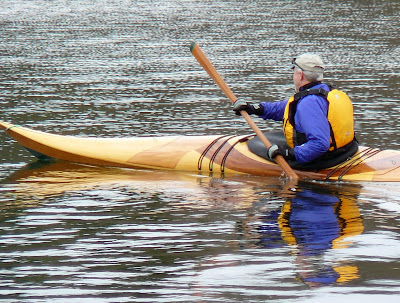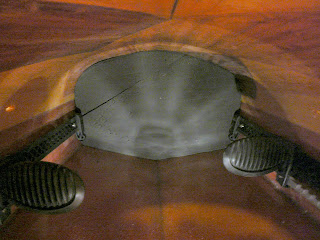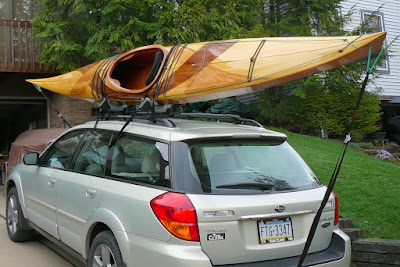In the interest of not further damaging my standing amongst boat-builders, I might have opted to keep this affair altogether private - if it weren't for the fact that the weather has been cold (40s), windy (25+ knots) over the past weekends. Neither sailing nor paddling would be all that appealing under those conditions. Hence, some spare time was available.
Some might say that "it was bound to happen". Well yes! In fact, Nick Schade maintains that a kayak only become a perfect boat after it has sustained its first major scratch... but I don't think that he had this kind of accident in mind.
The first darn dent. Ouch - dagger-in-the-heart kind of mishap. Alright, calm down - so tell me what exactly happened? Well, I neither ran over a sharp rock nor banged into a concrete pier. Here goes:
So, after much thought on convenient and safe storage of the kayak, I had devised a fine minimalist method of storing the kayak in the garage while (at least in principle) allowing for my car to once again find room next to my wife's car.
I knew that eventually I would want to construct a rack that would accommodate my next kayak right underneath but in the meantime, here I had come up with a simple method, employing the two safety lines used to secure the ends of the boat on top of the car roof during transport. The little ratchet mechanism made it easy to gradually elevate the boat from two saw horses right along the wall of the garage.
So far so good. When I had first attached the metal hook to the safety line, I used a simple knot that has never failed on my spinnaker sheets.
Alas, I failed to recognize that this might not work so well when tying line to a smooth stainless steel hook which does not offer the same kind of friction. To make a long story short, while retrieving the boat for my next paddle, one of the trusted knots failed spontaneously and the back end of the hull dropped 2 feet and landed on the corner of the saw-horse before I could catch it.
 Yikes! My heart leaped into my throat as I lowered the other side before I could turn the hull and examine the spot when the hull impacted on the saw-horse.
Yikes! My heart leaped into my throat as I lowered the other side before I could turn the hull and examine the spot when the hull impacted on the saw-horse. Okay, it could have been a lot worse... such as if the knots had failed while I was not standing right there and the boat would have dropped all the way to the ground... at any rate, it was not a pretty sight and clearly, the fiber glass had cracked underneath the biggest dent.
I sanded the area lightly in order to better see where and how the impact had occurred.
Yep! Clearly something had to be done! I certainly did not want to risk letting water penetrate the wood. I emailed Dr. Joey some pictures and after a consult, I had the action plan I needed.
- Isolate and mask off the trouble spot
- Sand through the fiber glass all the way down to bare wood.
- Apply steam to the dents to allow the wood to "un-dent" itself.
- Fill any remaining cracks with light thickened epoxy as needed
- Sand
- Fiberglass over the area
- Blend into the fiber glass around
- Fill weave with epoxy
- Sand
- Many layers of varnish
- Sand and polish
 "But Joey", I asked: "That process will take weeks, right!?" "Not really", he answered.
"But Joey", I asked: "That process will take weeks, right!?" "Not really", he answered.As it turns out, the secret to greatly expediting these steps is to use the heat of a lamp positioned closely so that the process of curing epoxy and varnish takes a lot less time.
 |
| Down to bare wood |
It was an opportunity to learn something new, something important about strip plank repair.
 |
| Close to being finished |
The total repair was accomplished over three evenings.
Now that this was taken care of, I obviously, attached the hooks with a different knot which could not possibly slip.
Obviously I should now have the confidence to store the boat in the same manner.
However, I decided to seize the moment and go ahead to build the rack now rather than later.
After weighing a variety of design options, I picked one that was relatively easy to accomplish with hand tools only.
2X4's dove-tailing at a slight upward angle into 2X8 uprights.
As you can see, I am now able to also store my little yellow kayak - albeit temporarily - until I have built my next kayak.
I am glad that the repair went so quickly because I am going to the CLC sponsored OkoumeFest which is coming up next weekend..
Perhaps we'll see you there ~~~












































